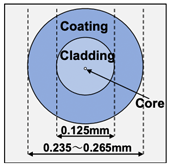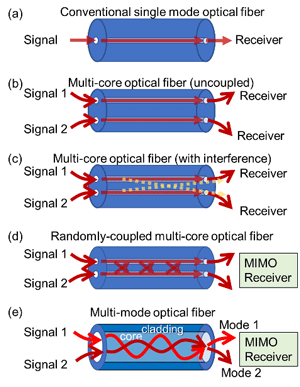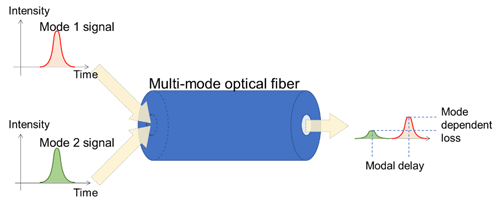International research group
1. National Institute of Information and Communications Technology, Japan
2. Eindhoven University of Technology, The Netherlands
3. Politecnico di Milano, Italy
4. University of Stuttgart, Germany
5. Sumitomo Electric Industries Ltd., Japan
Petabit, Terabit
1 petabit is 1,000 trillion bits, 1 terabit is 1 trillion bits, and 1 gigabit is 1 billion bits. 1.02 petabits per second is the capacity to transmit approximately 26 times the total download traffic for subscribers of Japan's fixed broadband Internet service as of November 2024.

Figure 2 Cross-section of a common standard single-mode optical fiber
Standard cladding diameter optical fiber
International standards specify that the outer diameter of the glass (cladding) of the optical fiber is 0.125 ± 0.0007 mm, and the outer diameter of the coating layer is 0.235 - 0.265 mm as shown in Figure 2. The optical fiber widely used in current optical communication systems is a single-core single-mode optical fiber with a cladding diameter of 0.125 mm.
Capacity-Distance Product
The biggest advantages of optical fiber transmission are the large capacity to use many wavelengths by taking advantage of the wide wavelength range of light, and it is carrying capacity with little signal degradation even over long distances. Therefore, as a general indicator of the transmission capability of an optical transmission system, not only capacitance and distance, but also the product of these may be used. The unit is expressed in bits per second and km.
Highest ever recorded
As of the presentation at OFC2025 on April 3, 2025, this new record has broken the world record for "capacity-distance product" in a transmission demonstration using a standard cladding diameter optical fiber (according to a survey by NICT).

Figure 3 Conceptual images of optical fiber transmission schemes
Multi-core optical fiber
Standard single-core/single-mode optical fiber (see Figure 3(a)) has a capacity limit of approximately 250 terabits per second. To address this limitation, multi-core optical fibers with increased number of cores (light paths) (see Figure 3(b)) and multi-mode optical fibers have been investigated. If the cores of a multi-core optical fiber are close to each other, the signal in one core leaks into the other cores, causing signal quality degradation due to interference (see Figure 3(c)). To suppress signal interference, core spacing of an uncoupled multi-core optical fiber is appropriately increased.
Coupled multi-core optical fiber
Coupled multi-core optical fiber (see Figure 3(d)) is a kind of multi-core optical fiber in which cores are densely arranged on the premise of eliminating signal interference between cores through MIMO digital signal processing. Compared to multi-mode optical fiber, randomly coupled multi-core optical fiber has uniform signal propagation characteristics in each core, making it suitable for long-distance transmission. However, to ensure the randomness of coupling between cores required for long-distance transmission, the core spacing must be strictly controlled.
MIMO digital signal processing
In the transmission using multi-mode fiber or randomly coupled multi-core optical fiber, Multi-Input-Multi-Output (MIMO) processing for mode/core separation is almost inevitably required at the receiver side. MIMO is a signal processing technology for eliminating multipath interference in wireless communications. In optical communications, it is used to eliminate interference between various optical signals propagating in the same optical fiber.
Multi-mode fiber
A multi-mode optical fiber has a large core diameter, and multiple modes exist within the core (see Figure 3(e)). Inter-modal signal interference occurs during multi-mode optical fiber propagation, at the optical fiber connections, and also at the input/output. Therefore, it is important to eliminate the interference by using MIMO digital signal processing. Multi-mode optical fiber transmission of 55 modes at maximum was realized.
Propagation characteristics for each mode
Multi-mode optical fiber generally has mode-dependent propagation loss and time delay as shown in Figure 4. When the mode dependent loss is large, the quality of the signal deteriorates. When the propagation time delay difference is large, the power consumption required for MIMO digital signal processing becomes large.

Figure 4 Mode-dependent propagation characteristics
Wavelength band
The wavelength bands used for telecommunication applications are the C band (wavelength 1,530 to 1,565 nm) and L band (1,565 to 1,625 nm); other bands include the O band (1,260 to 1,360 nm), E band (1,360 to 1,460 nm), S band (1,460 to 1,530 nm), and U band (1,625 to 1,675 nm). In this study, C-band and L-band were used.
16QAM
Quadrature Amplitude Modulation (QAM) is a kind of multi-level modulation that uses both the phase and the amplitude of light to represent multiple bits. In 16QAM, each symbol can have 16 different phases and amplitudes in the complex plane and can represent 4-bit information (24 = 16).
.png)



